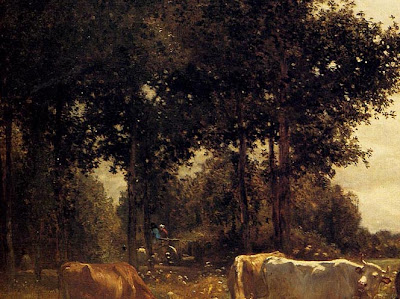
In this detail of a Claude Lorrain, there are fewer than ten skyholes painted in the lower third of the main tree. I’ve noticed that the early landscapists were sparing with skyholes.

This detail by Corot shows skyholes nearer the top margin of the trees. Some appear as fairly active circular shapes, which draws attention to them.

Constant Troyon, as seen in this detail, painted skyholes of various sizes, and gave them a ragged character, to suggest that they were fringed with leaves.
One question that every painter in opaque media like oil, gouache, or acrylic faces: Should you paint a skyhole with the same exact color as the sky beyond?

If you compare a photograph to the paintings we’ve seen, it appears much more complex and full of infinite variety. In the center of the photo I’ve placed the number 1 next to a prominent skyhole, and the number 2 surrounded by a group of smaller skyholes.

An enlargement reveals that while the larger skyhole does present an uninterrupted view of the sky, the smaller skyholes contain a network of fine branches and tiny leaves that weren't apparent from a distance.
These tiny interruptions lessen the amount of light passing through from the sky. As a result, these skyholes should really be painted a little darker than the actual sky color beyond.
Images from ARC, Link.
Tomorrow: Your Art-by-Committee Sketches
Không có nhận xét nào:
Đăng nhận xét